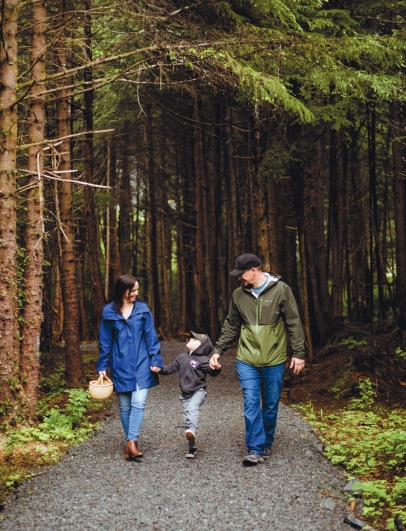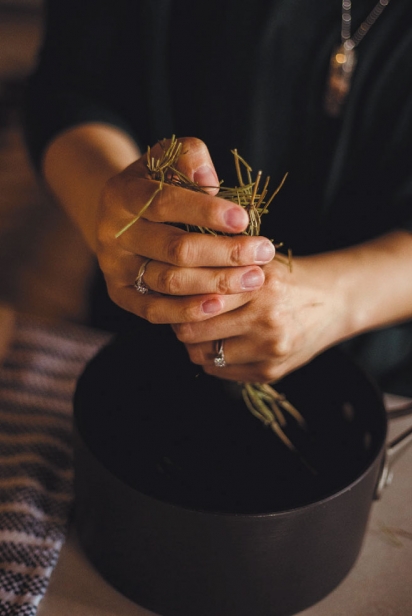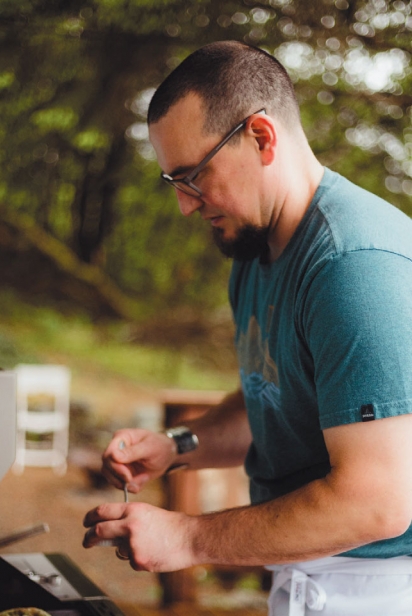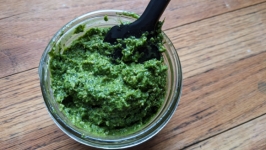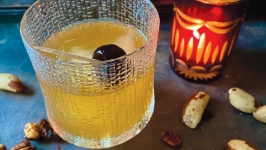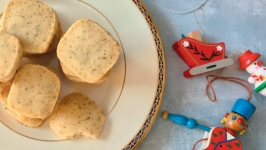Wild Harvests, Wild Love
The sun lit up the translucent tiny gems that dangled from the lush green branch, making them irresistible to my six-year-old bestie and me. We popped a few into our mouths, giggling as they burst like tiny water balloons onto our tongues.
“Stop! Girls!” my friend’s mom yelled at us, obviously panicked by our playful indulgence. “Those berries are poisonous!”
The cautious belief that all wild plants are poisonous is common.
“Steer clear!” and “Don’t touch those!” are but a few of the stern warnings I have heard in my pursuit of the wild botanicals of Southeast Alaska. There has always been something in me that is drawn to the native vegetation of my surroundings. This hunger has opened up a whole new world to me, one I am passionate about sharing. Those berries of my childhood were not poisonous. They are nicknamed watermelon berries because of their sweet melon flavor. Our Tlingit ancestors referred to them as “scoot berries,” for their mild laxative effect. Fun fact: they can also be used to ease hangover blahs!
I believe that our Tlingit elders were very knowledgeable about edible plants, but much of that knowledge sadly has been lost through years of westernization. Add to that the fear of the unknown (making everything possibly poisonous) and much of our natural abundance around us is being forsaken. It doesn’t have to stay that way.
As a young teenager, I began pouring through plant identification books and experimenting in the kitchen. My fascination with creating original recipes of irresistible dishes and elixirs grew with me. As an adult, I began documenting my excursions and creations with photos, notes, and journaling. My first attempt at sharing online was a website called Backyard Kitchen. It evolved into Plant Guru after collaborating with a friend who studied ethnobotany. We dreamed up and created an indigenous plant identification app. A year of researching, planning, and seeking out app companies to make our dream a reality ended with discovering the perfect company capable of creating such an app. Much to our disappointment, they were already working with a university on the same app! The plus side is there is now a whole slew of amazing plant identification apps to assist the curious forager.
My love for all things culinary led to the love of my life. Lucas was a sous chef for a fine dining restaurant, and I was a wine server. Our similar interests made for an adventurous courtship. His hunting and fishing and my foraging melded together for the perfect pairing, and we naturally hosted dinner parties to celebrate and bring together friends and family. We enjoyed showcasing our freshest wild game and Indigenous foods in new ways.
Over the years, Lucas’ culinary skills have served as the foundation for our recipes, complemented by my knowledge of local plants. Our recipes are often crafted on a whim while we are cooking dinner, and other times we sit and dream up all the new recipes we will create, especially if they are for a dinner party or for special guests. Our passions led me to create Forest Fresh (forestfreshalaska.com), a forest-to-table cooking blog that features indigenous plants, seafood, and wild game. We harvest from the ocean and rainforest to create crave-worthy meals.
Since then, we have not only inspired home cooks to create with a fresh outlook but have made an impression in other ways as well. Justyne Wheeler, owner of Village Coffee Company in Yakutat, enlisted the help of Forest Fresh to expand her coffee truck menu. Maybe it was because I am her big sister, or maybe she was truly inspired by my mouthwatering social media feed? Either way, Justyne requested tailored recipes exclusive to Village Coffee Company customers.
“Living in Alaska, we have the advantage of literally walking out our back door and harvesting berries and plants. It’s so amazing to have easy access to this, and it felt wrong not to incorporate what nature gives us and prepare it to make delicious food or beverage items for my coffee shop,” Justyne said.
We started with Spruce Tip & Strawberry Italian Soda, crafted with a homemade spruce tip syrup. This sparked her imagination, and she turned some of Yakutat’s tastiest flavors into syrups for flavoring Italian sodas and energy drinks—rhubarb, wild blueberry, beach strawberry, and salmonberry. Her customers approved! Wild Blueberry Lemonade Lotus energy drink remains her most requested beverage. Customers love her Wild Beach Strawberry Paninis, Smoked Salmon & Herbed Breakfast Sandwiches (made with the delicious deer heart plant), Salmonberry Blossom Tea, Spruce Tip Granola, Salmonberry Creamsicles, and Potato Frittata with Beach Greens.
We also created informational cards to display nutritional information and other tips for her curious customers.
“With Forest Fresh’s knowledge of Southeast indigenous plants, I knew Mary and Lucas could help put together a unique blend of recipe cards for Village Coffee Co.,” Justyne said. “The laminated cards were beautifully done and perfect for the front windows at the shop where the recipe cards listed the vitamins of each wild plant/berry in the recipe and the importance of it. Not only were my customers educated but I also learned a lot in the process.”
Village Coffee Company is making local food sources available in innovative ways, beyond traditional jams and jellies. It’s exciting to us, because we believe that indigenous plants and wild foods make for a more authentic local experience, and they play a part in our food security and food sovereignty. Not to mention the vast taste difference in using actual forest fresh ingredients!
Sharing a passion for utilizing wild ingredients in our meals, Lucas and I hope to inspire our readers to create meals with their own forest fresh ingredients. We’re sharing two recipes with you here, Horsetail Tea, and Wild Pesto Chicken. Enjoy, and stay curious!
Editors’ note: while there are many delicious edible wild foods, some are toxic. Learn from a trusted expert and only harvest what you know to be safe. Also, harvest wild foods with care for others—humans and animals— who might need them to survive. Guidelines vary by species, and typically range from 1—30 percent of what you can see. Harvest only what you need, and only if ample abundance ensures sustainability.


